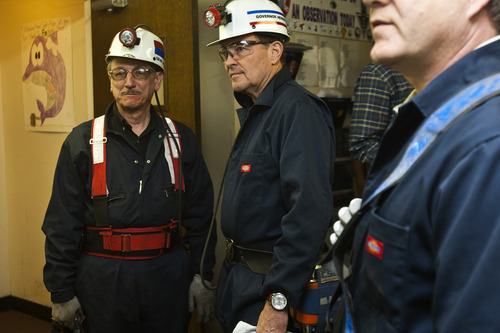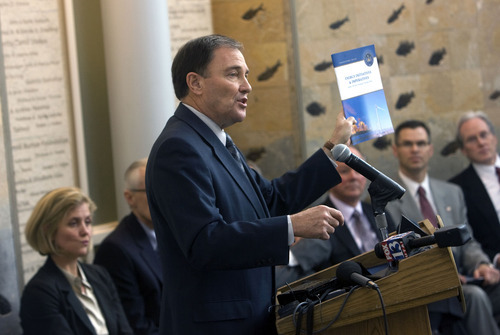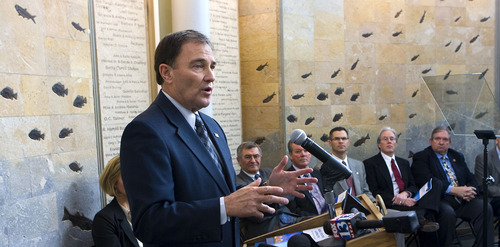This is an archived article that was published on sltrib.com in 2012, and information in the article may be outdated. It is provided only for personal research purposes and may not be reprinted.
Gov. Gary Herbert has raised several times as much for his campaign as all of his Republican challengers combined, with nearly $1 out of every $6 in donations coming from oil, gas, oil shale and other energy interests.
Herbert has raised nearly $1.5 million for his re-election campaign since Jan. 1, 2011, largely from his annual fall gala, but also through a series of other events during the year. He has spent more than $900,000 during that period campaigning for re-election.
"We knew the convention process would cost some money. It's a very labor-intensive process, talking to delegates one-on-one and using both paid staff and volunteers to do that," said Scott Ericson, Herbert's campaign manager.
The average donor to the campaign gave more than $3,750, with several big-ticket donors giving upward of $25,000 each, many of them to sponsor Herbert's annual fall fundraising gala.
Traditionally, Realtors and real estate interests have been the most generous contributors to Herbert, who is a former president of the Utah Association of Realtors.
This year, however, energy companies were easily his largest contributor, giving more than $235,000 to Herbert's campaign over the last 16 months.
—
Big donors • Kimball Rasmussen, CEO of Deseret Power and an outspoken critic of solar and wind energy alternatives, gave $50,000 to Herbert's campaign. CONSOL Energy, which operates one coal mine in Utah and recently closed another, gave Herbert $30,000.
Andadarko Petroleum Corp., which recently announced a major oil field development near Vernal in cooperation with the environmental community, gave the governor $25,000.
Real Estate developers and housing interests gave Herbert more than $200,000. Medical companies contributed more than $90,000 to his campaign, and technology companies gave more than $63,000.
"All of these financial disclosures are made available to the public," Ericson said. "We feel it's important that there is full disclosure so everyone knows where the money is coming from and let voters make decisions based on the public information that is available to them."
Environmentalists said the contributions are not necessarily surprising and come from companies that stand to benefit from Herbert's policies.
"These disclosures make clear who stands to benefit from the public land takeover that Governor Herbert is supporting — the real estate industry, oil shale and oil and gas developers," said Steve Bloch, an attorney with the Southern Utah Wilderness Alliance. "Utahns should be outraged that these are the private interests who stand to benefit from the legislation signed earlier this spring by the governor."
John Weisheit of the group Living Rivers said that, in his mind, the donations raise questions about how much access certain energy companies have to the governor and his staff and why some groups get energy projects approved more quickly than others.
"I'm not surprised at all. I think that's what is driving the governor's 10-year energy policy," said Weisheit, whose group is challenging an oil shale project proposed by Red Leaf Resources, which gave $5,000 to the governor.
"They rubber stamp this stuff and we felt as citizens that they ought to have a better review," he said.
—
One of pillars • Tim Chambless with the Hinckley Institute of Politics at the University of Utah, said in speeches around the state, including a recent speech to business leaders, Herbert has emphasized energy development as one of the four pillars of his administration.
"He was sending a message to that particular audience that he is thinking energy," Chambless said. "He's thinking development rather than conservation and, as a result, these folks are rewarding him with contributions."
Herbert has raised and spent about seven times as much money on his campaign as his three closest competitors combined.
Former state Rep. Morgan Philpot raised nearly $46,000 and spent just under $21,000 on his campaign. Rep. Ken Sumsion raised almost $33,000 and spent more than $24,500 on his race.
Tea party co-founder David Kirkham raised about $124,000 and has spent almost $91,000. Several of Kirkham's largest donors are car collectors and customers who have purchased custom-made roadsters from Kirkham's Provo company, Kirkham Motorsports.
He said those contributions are different from the companies that gave to the governor.
"Deseret Power obviously has business here. My donors don't. These are people who just believe in me," Kirkham said.
He said that as long as voters have all the information on the governor's contributors voters can make up their own minds on whether they think it is an issue for them.
In 2010, Herbert's Democratic opponent, Salt Lake County Mayor Peter Corroon, raised questions about whether Herbert's donors were getting special treatment, including a major donor that won a $1.1 billion contract to rebuild Interstate 15 through Utah County.
The contract process was badly flawed and resulted in a $13 million settlement payment with a losing bidder.
Corroon lost that election by a two-to-one margin.
Twitter: @RobertGehrke —
Campaign cash
The following are the top sectors contributing to Gov. Gary Herbert's re-election campaign since Jan. 1, 2011:
Energy • $235,500
Real Estate • $205,075
Medical • $93,000
Dietary Supplements • $75,500
Tech • $72,500
Banking & Finance • $62,500
Source: Campaign disclosures for the governor's campaign account and political action committee.







